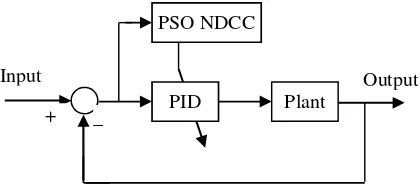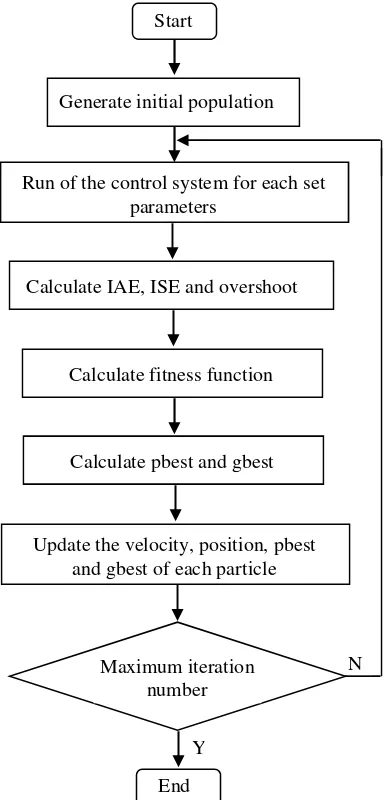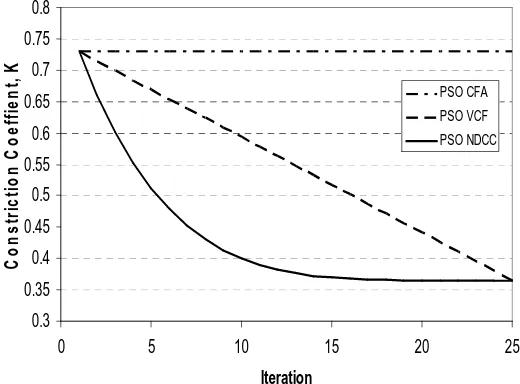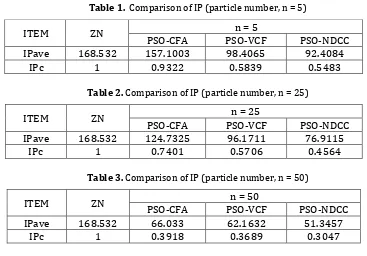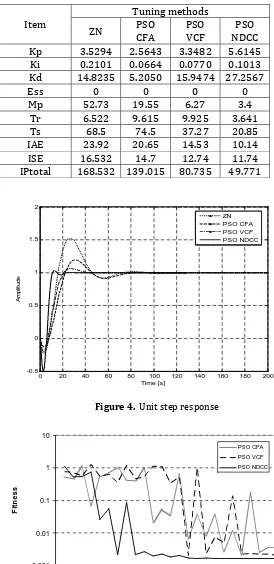PID Controller Design of Nonlinear System using a New
Modified Particle Swarm Optimization with Time-Varying
Constriction Coefficient
Alrijadjis1, Shenglin Mu2, Shota Nakashima3, Kanya Tanaka4
1)PoliteknikElektronikaNegeri Surabaya, 2)Hiroshima National College of Maritime
Technology, 3),4)Yamaguchi University
1)Jl. Raya ITS, Keputih, Sukolilo, Surabaya, Indonesia, Telp. +62(31)5947280, 2)
4272-1 Higashino, Osakikamijima, Toyota District, Hiroshima 725-0234272-1, Japan, Telp. +84272-1- +81-846-65-3101, 3),4)2-16-1 Tokiwadai, Ube-shi 755-8611, Japan, Telp.
+81-836-85-9005
E-mail: 1)[email protected], 2)[email protected], 3)[email protected], 4)[email protected]
Abstract
The proportional integral derivative (PID) controllers have been widely used in most process control systems for a long time. However, it is a very important problem how to choose PID parameters, because these parameters give a great influence on the control performance. Especially, it is difficult to tune these parameters for nonlinear systems. In this paper, a new modified particle swarm optimization (PSO) is presented to search for optimal PID parameters for such system. The proposed algorithm is to modify constriction coefficient which is nonlinearly decreased time-varying for improving the final accuracy and the convergence speed of PSO. To validate the control performance of the proposed method, a typical nonlinear system control, a continuous stirred tank reactor (CSTR) process, is illustrated. The results testify that a new modified PSO algorithm can perform well in the nonlinear PID control system design in term of lesser overshoot, rise-time, settling-time, IAE and ISE.
Keywords: PID controller, Particle Swarm Optimization (PSO), constriction factor, nonlinear system.
1. INTRODUCTION
flight control, instrumentation, etc. However, it is a main problem how to choose PID parameters. PID controllers can provide robust and reliable performance for most systems if the PID parameters are tuned properly. Various tuning methods are explained in [1-3]. But, these conventional tuning less optimal because its use assumption that the system have minimum dynamic characteristic, linear (LTI), no-disturbance. In fact, industrial processes are nonlinear, time-varying and complex [4], [5].
Several optimization methods for tuning PID parameters have been developed, including LQR method, the results of this method is optimal, but requires complex mathematical calculations [6]. To avoid the complex mathematical calculaton, many researchers have developed intelligent softcomputing for optimal tuning PID parameters, such as Genetic Algorithm (GA), Tabu Search (TS) and Simulated Annealing (SA) have recently received great attention for searching global optimal solution and achieving high efficiency [7],[8]. GA method is usually faster than TS and SA methods because of employing parallel search techniques. Though, the GA method has been employed successfully for global optimization, recent research has identified some deficiencies in GA performance. This degradation in efficiency is apparent in applications with highly epistatic objective function (where the parameters being optimized are highly correlated), the crossover and mutation operations cannot ensure better fitness of offspring because population chromosomes have similar structure and their fitness are high toward the end of the process [9]. To overcome GA difficulties, Kennedy and Eberhartin their paper proposed PSO method. PSO is one of the modern heuristic algorithm developed through simulation of a simplified social system and has been introduced in various application fields in recent years. Generally, it is characterized as a simple concept, easy to implement and computationally efficient.
In this work, a new modified PSO with time-varying nonlinear decreased constriction coefficient was applied to optimize the PID parameters for nonlinear system. To show the effectiveness of our proposed method, the step responses of closed loop system were compared with that of the existing methods (ZN, PSO-CFA and PSO-VCF). The reminder of this paper is organized as follows. Section 2 introduces the particle swarm optimization algorithm. Section 3 describes the proposed PSO with time-varying nonlinear decreased constriction coefficient. Application of our proposed algorithm to optimal PID tuning is described in section 4. Section 5 describes result and discussion. Finally, section 6 concludes the paper.
2. PARTICLE SWARM OPTIMIZATION ALGORITHM
d
t : pointer of iteration (generations) )
: velocity of particle i at iteration t
w : inertia weight factor
c1, c2 : acceleration constant (learning rate)
: current position of particle i at iterations
pbesti : best previous position of the ith particle
gbest : best particle among all the particles in the population
3. PROPOSED MODIFIED PSO
The inertia weight w plays an important role in the convergence of the PSO algorithm to the global optimal solution and hence has an influence on the time taken for a simulation run. Recall here that the weight factor is used to control the influence of the previous history of the particle velocities on both the current velocity and the local and global exploration capabilities of the PSO algorithm. It thus follows that the reason for using a linearly decreasing-in-time inertia weight parameter w is that larger values of w tend to be used at the start of the search to enable the PSO algorithm to explore globally the solution space, whereas smaller values of w are used toward the end of the search to enable the PSO algorithm to explore locally around the global optimum before finally homing in onto it.
Recent works in [14] indicate that the use of a “constriction factor” may be necessary to insure convergence of the PSO. A simplified method of incorporating a constriction factor is represented in:
range of the variable xmax in each dimension. It was also shown in [14] that
this approach provides a performance superior to any similar technique reported in the literature.
Ali T. Al Awami proposed a PSO with variable constriction factor for adaptive channel equalization by introducing a time-varying linearly-decreasing K, instead of a fixed one. This is done by adjusting k at every iteration according to the following formula [15]. He calls his method as PSO VCF (PSO Variable Constriction Factor).
( ) Decreased Constriction Coefficient) method in this work, a new modification of the constriction factor-based technique for optimal tuning of PID parameters by introducing a time-varying nonlinearly-decreasing K. This is done by adjusting k at every iteration according to the following recursion:
(
)
x4. PSO-NDCC BASED PID CONTROLLER
Design of PSO NDCC based-PID controller for plant is shown in Fig. 1. In this system, three PID parameters, i.e., the proportional gain Kp, integral gain Ki, and derivative gain Kd, will be tuned optimally by IPSO algorithm.
Performance index that is used to estimate the PID parameters are
∫
=Te t dt ISE
0 2
) (
(8)
where IAE is an integral absolute error and ISE is an integral square error.
The main concept of PID controller tuning for on-line system is tuning the PID parameter of each sampling time. The objective function or fitness function that will be optimized is expressed as follows:
( () ()) . () .
)
(i IAE i ISE i O i
J =α + +β
(9)
where :
α, β : improvement factor O : overshoot
Flowchart of the IPSO-PID controller is shown in Fig. 2.
Start
Generate initial population
Run of the control system for each set parameters
Calculate IAE, ISE and overshoot
Calculate fitness function
Calculate pbest and gbest
Update the velocity, position, pbest and gbest of each particle
Maximum iteration number
End Y
N
5. RESULTS AND DISCUSSION
In order to illustrate the between the PID tuning process with PSO-NDCC and the other methods (ZN, PSO-CFA, and PSO-VCA), the following model (10) is taken from [16]. This model is a CSTR process model and it is typical of nonlinear systems.
)
Using three different methods (PSO-CFA, PSO-VCF and PSO-NDCC), tuning process is applied to this model. Because of the probabilistic nature of the PSO algorithm, tuning process was run five times for each method.
The strategy approach to a value of constriction coefficient for each method is shown in Fig. 3. In this experiment, we used kmax = 2, kmin = 1 and x
= 5 for PSO VCF and PSO NDCC.
To examine effectiveness and ability to find global optima, we used three categories of population size, the first, small population size (n = 5), the second, medium size population (n = 25) and the last large population size (n = 50). Other used parameters are:
1. Iteration number, iter = 25 2. Cognitive constant, c1 = 2.05
3. Social constant, c2 = 2.05
To evaluate the general performance of system, the following equation (11) is taken from [17].
Where IPtotal is index performance total, Mp is maximum overshoot in
percent, tr is rise-time in second, ts is settling-time in second, IAE is integral absolute error, and ISE is integral square error. The smallest of IP shows that the performance is best. A comparison of the average of index performance from five running is tabulated as given in Table 1-3. It is found very clearly that our proposed method has a smallest IP in all of particle number and its mean that PSO NDCC can improve performance of system. IPc is the ratio of IP value to maximum IP of ZN method.
Table 1. Comparison of IP (particle number, n = 5)
ITEM ZN n = 5
PSO-CFA PSO-VCF PSO-NDCC
IPave 168.532 157.1003 98.4065 92.4084
IPc 1 0.9322 0.5839 0.5483
Table 2. Comparison of IP (particle number, n = 25)
ITEM ZN n = 25
PSO-CFA PSO-VCF PSO-NDCC
IPave 168.532 124.7325 96.1711 76.9115
IPc 1 0.7401 0.5706 0.4564
Table 3. Comparison of IP (particle number, n = 50)
ITEM ZN n = 50
PSO-CFA PSO-VCF PSO-NDCC
IPave 168.532 66.033 62.1632 51.3457
IPc 1 0.3918 0.3689 0.3047
A comparison of time domain specifications maximum overshoot, rise-time, settling-rise-time, IAE and ISE are tabulated as given in Table 4. As can be seen that PSO NDCC significantly reduce the overshoot. Rise-time, settling-time, IAE and ISE have also improved. Henceforth, outperforms that of the conventionally Ziegler-Nichols method.
Among five runs for each method, the best result for step input is shown in Fig.4. It is found clearly that PSO NDCC outperform the previous methods. All of time domain specifications of PSO NDCC are better than previous methods.
Figure 5 shows the result of convergence characteristic for our proposed method and previous methods. It is found that our proposed method have quick convergence better than PSO CFA and PSO VCF at 9th
Table 4. Comparison of time domain specifications
Item
Tuning methods
ZN PSO
CFA
PSO VCF
PSO NDCC
Kp 3.5294 2.5643 3.3482 5.6145
Ki 0.2101 0.0664 0.0770 0.1013
Kd 14.8235 5.2050 15.9474 27.2567
Ess 0 0 0 0
Mp 52.73 19.55 6.27 3.4
Tr 6.522 9.615 9.925 3.641
Ts 68.5 74.5 37.27 20.85
IAE 23.92 20.65 14.53 10.14
ISE 16.532 14.7 12.74 11.74
IPtotal 168.532 139.015 80.735 49.771
0 20 40 60 80 100 120 140 160 180 200
-0.5 0 0.5 1 1.5 2
Time [s]
A
m
p
lit
u
d
e
ZN PSO CFA PSO VCF PSO NDCC
0.001 0.01 0.1 1 10
0 5 10 15 20 25
Iteration
F
it
n
e
s
s
PSO CFA PSO VCF PSO NDCC
Figure 4. Unit step response
6. CONCLUSIONS
In this paper, a new modified PSO or we call as PSO NDCC for nonlinear system is proposed. It is shown analytically and graphically that there is a substantial improvement in the time domain specification is term of lesser overshoot, rise-time, settling-time, IAE and ISE. Also, our proposed method improved the accuracy searching and the speed convergence.
REFERENCES
[1] Li Xu-zhou, Yu Fei, Wang You-bo,PSO Algorithm Based Online Self-tuning of PID Controller, International Conference on Computational
Intelligence and Security, 2007
[2] S.M. Giriraj Kumar, Deepak Jayaraj, Anoop R. Kishan,PSO Based Tuning of a PID Controller for a High Performance Drilling Machine,
International Journal of Computer Application (0975-8887), Volume 1,
No. 19, 2010
[3] P. Cominos, N. Munro,PID Controller: recent tuning methods and design to specification, IEE Proceeding Control Theory and
Applications, pp.46-53, 2002
[4] K. Astrom, T. Hagglund, The Future of PID Control, Control Engineering Practice Vol. 9, pp. 1163-1175, 2001
[5] Halevi. Y, Palmor. Z.J, Efrati. T, Automatic Tuning of Decentralized PID Controller for MIMO Processes, Journal of Process Control, Vol. 72, pp. 119-128, 1997
[6] G. Yu, R. Hwang,Optimal PID Speed Control of BLDC motor using LQR Approach, Proceeding IEEE Int. Conf. System, Man and Cybernetics, pp. 473-478, 2004
[7] Zhou. G, J. Birdwell,Fuzzy Logic-based PID Auto-tuner Design Using Simulated Annealing, Proceeding of the IEEE/IFAC Joint Symposium,
Computer Aided Control System Design, pp. 67-72, 1994
[8] Haupt. R.L, S.E Haupt, Practical Genetic Algorithm, 2nded, John Wiley and Sons Inc, ISBN 0-471-18873-5, 1998
[9] Kennedy J, EberhartC,Particle Swarm Optimization, Proceeding IEEE
International Conference on Neural Networks, pp. 1942-1945, 1995
[10] Iraj Hassanzadeh, SalehMobayen,PSO-Based Controller Design for Rotary Inverted Pendulum System, Journal of Applied Sciences 8 (16), pp. 2907-2912, 2008
[11] M. El Said El Telbany,Employing Particle Swarm Optimizer and Genetic Algorithm for Optimal Tuning of PID Controller: A Comparative Study, ICGST-ACSE Journal, Vol. 7, 2007
[13] Ahmad Nickabadi, M. Mehdi Ebadzadeh, Reza Safabakhsh,A Novel Particle Swarm Optimization Algorithm with Adaptive Inertia Weight, Journal of Applied Soft Computing 11, pp. 3658-3670, 2011 [14] R.C Eberhart, Y. Shi,Comparing Inertia Weight and Constriction
Factors in Particle Swarm Optimization, Proc. 2000 Congress on
Evolutionary Computation, pp. 84-88, 2000
